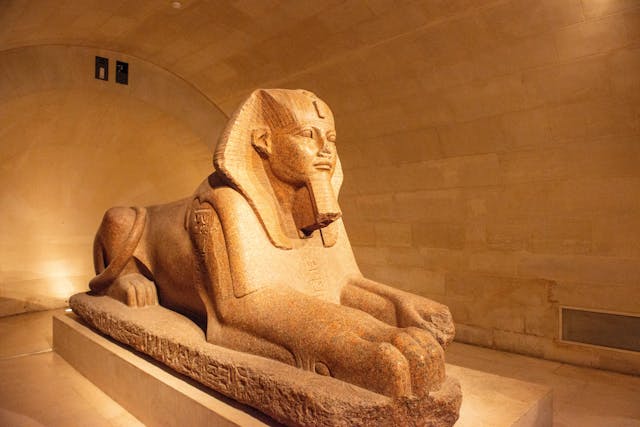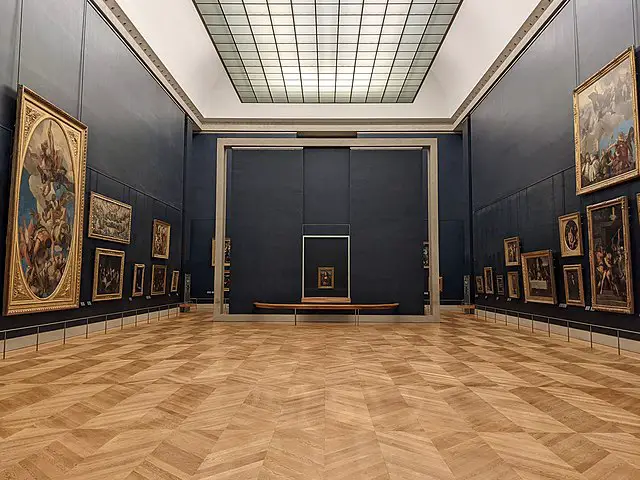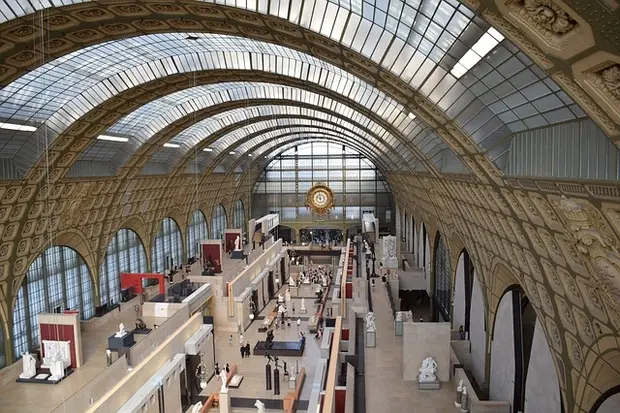The world’s largest art museum is full of fascinating secrets that go beyond its famous masterpieces.
Discover the surprising stories, captivating mysteries, and unusual details behind the walls of the Louvre!
1. The Hidden Fortress

Beneath the Louvre lies a hidden treasure: the remains of a medieval fortress!
Before it became one of the world’s most famous museums, the Louvre was a veritable fortress, erected in the 12th century by the King of France, Philip Augustus, to protect Paris.
Beginning in 1528, the fortress was gradually demolished to make way for the modern Palace. However, some of the well-preserved walls and towers are still visible today and open to the public!
2. Secrets of the Mona Lisa

The Mona Lisa is a mysterious masterpiece full of secrets!
Leonardo da Vinci magically brought Mona Lisa to life on canvas. Her enigmatic smile seems to disappear when you look too closely, her captivating gaze follows you around the room, and even her pulse appears visible.
Experts discovered subtly superimposed layers of paint, attesting to Leonardo da Vinci’s changing inspiration and his quest for perfection.
In short, the Mona Lisa remains an enigma for art lovers and curious people, and that’s what makes it so charming!
3. The Louvre in Wartime
During the Second World War, the Louvre faced a major challenge: protecting its precious works of art from the dangers of the conflict.
As soon as war was declared, the museum took steps to safeguard its treasures, moving the works to secure châteaux across France.

This move ensured the safety of its most precious masterpieces, such as the Mona Lisa and the Venus de Milo. The most fragile pieces were kept in basements.
Museum employees played a crucial role in preserving the works throughout the war!
4. Ghosts of the Louvre
Legends of ghosts haunt the corridors deep within the Louvre. Some visitors and employees claim to have felt a strange presence in the galleries.
One of the best-known stories is that of the ghost Belphegor. This frightening monster is said to have taken possession of a mummy in the Louvre, spreading terror around the museum at nightfall. This story has inspired numerous books and movies.
Other legends mention protective spirits who watch over the works of art.
5. The Great Sphinx of Tanis

The Great Sphinx of Tanis is one of the Louvre’s masterpieces. This magnificent pink granite sculpture was discovered in Tanis, Egypt, in 1825. A year later, it joined the Louvre’s collections.
Transporting this imposing sculpture to the museum was no mean feat, given its size and fragility. Measuring over 15 feet in length, it weighs almost 12 tons!
Today, the Great Sphinx of Tanis is a must-see at the Louvre, offering fascinating insight into ancient Egypt.
6. Napoleon’s Influence

Napoleon Bonaparte had a significant impact on the Louvre, in terms of both its collection and its architecture. As a passionate art lover, he enriched the museum with treasures brought back from his military campaigns across Europe.
In 1802, he renamed the museum the Musée Napoléon and cleared the premises, removing all occupants from the Louvre and shutting down shops in the courtyards to prevent fires.
These actions helped to enlarge and modernize the museum, bringing Napoleon’s imperial vision to life. Even today, his influence can be seen in the many works associated with his reign.
7. The Louvre Pyramid

The Louvre Pyramid is one of the museum’s most striking additions, but its construction was no easy task! Inaugurated in 1989, this modern glass and steel structure by architect Ieoh Ming Pei divided opinion.
Some loved its contemporary look, while others found it too far removed from the classical architecture of the Louvre. There were even rumors that the glass panels numbered 666, the number of the Beast.
Despite the controversy, the Louvre Pyramid has become an iconic Paris landmark. It has modernized the museum’s entrance and attracts visitors from all over the world!
8. Revolutionary Works of Art
The Louvre’s revolutionary works of art form a captivating part of the museum’s history. After the French Revolution, the Louvre inherited numerous works from churches and noble estates that had been seized during this troubled period.
These treasures brought great variety and richness to the museum’s collections, ranging from paintings and sculptures to objects of decorative art.
This period also saw the museum’s doors opened to the public, making art accessible to all. Today, revolutionary works of art continue to captivate visitors, offering a unique insight into this crucial period in French history.
9. The Theft of the Mona Lisa

The theft of the Mona Lisa is one of the most famous events in the history of the Louvre.
In August 1911, the Mona Lisa disappeared from the museum. The man responsible, Vincenzo Peruggia, was a former employee who believed the painting should be returned to Italy.
He managed to take the painting with him by hiding it under his coat. For over two years, he kept the painting at his home in Paris. It was finally found in Italy when he tried to sell it!
This incredible story made the Mona Lisa even more famous and prompted museums to step up security measures to protect their irreplaceable works of art.
10. Secret Apartments

The Louvre’s secret apartments, located in the Richelieu wing, reveal the opulence of the Second Empire. These apartments, used by Napoleon III, are brimming with ornate details.
The rooms are a blend of elegant furnishings, sumptuous gilding, and wood paneling. Hand-painted ceilings, crystal chandeliers, and trompe-l’œil create a luxurious ambiance. The living rooms, bedrooms, and reception rooms are adorned with antique furniture and works of art, testifying to the emperor’s refined taste.
A tour of the apartments reveals Napoleon III’s life at the Louvre, and immerses visitors in the history of the imperial court!
11. Unusual Exhibits

The Louvre is full of astonishing exhibits, some of which stand out for their bizarre nature.
Among the most surprising objects is the imposing statue of Napir-Asu, weighing 1,750 kg (3,858 lbs), or even another 9,000-year-old work of art!
The museum also features unexpected paintings and unusual objects of decorative art, such as extravagant clocks and distinctive furniture.
These unusual works add a touch of originality to the Louvre’s collections.
12. The Egyptian Collection

The Louvre’s Egyptian collection is one of the most impressive in the world.
It all began in the early 19th century, when French explorer Jean-François Champollion deciphered hieroglyphics, sparking an interest in ancient Egypt. He then convinced French authorities to purchase private collections from European consuls in Egypt.
However, the acquisition of these treasures was not without controversy. Some objects were allegedly brought to France through theft and looting.
Today, the Egyptian collection is a must-see at the museum, offering a fascinating journey into ancient Egypt through its mysterious mummies and majestic statues.
13. The Salle des États

The Salle des États, or State Room, was built between 1855 and 1857 by architect Hector Lefuel. Under the Second Empire, it was used for annual legislative sittings and special ceremonies.
It was renovated in 1886 to showcase 19th-century French paintings, then remodeled again in 1950 to display the great Venetian paintings.
Today, the Salle des États is best known for housing Leonardo da Vinci’s famous Mona Lisa, displayed opposite Paolo Veronese’s masterpiece The Wedding at Cana. It’s a highlight for all visitors to the Louvre.
14. Animals in the Louvre

The Louvre is packed with sculptures and paintings depicting animals of all kinds, bringing a touch of life to its collections.
Among the most captivating sculptures are the Winged Bulls from Khorsabad, and the Lion with a Snake. The paintings are no exception, with scenes including Napoleon’s horses and hunting scenes.
These works offer a fascinating look at how artists from different eras captured and interpreted the animal kingdom. It’s a real journey through art history and a unique way to explore the Louvre!
15. The Cour Carrée

The Cour Carrée at the Louvre is a unique place within the museum, combining history and architectural beauty.
Construction on the unique square courtyard began in the 16th century under King Francis I but wasn’t completed until the 19th century.
The courtyard is surrounded by elegant Renaissance and classical facades and sculptures, with a fountain at its center.
The monograms of the sovereigns who contributed to its construction add a royal touch, making the Cour Carrée a unique place to relax and discover!
I aim to share my tips and recommendations for the beautiful country of France. My goal is to help you plan your next adventure, whether it’s a weekend getaway or a once-in-a-lifetime trip. From finding the best hotels and restaurants, to discovering unique activities and sights, I’ve got you covered!




